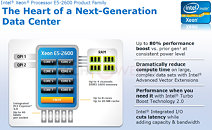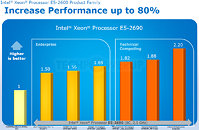- Joined
- Oct 9, 2007
- Messages
- 47,540 (7.46/day)
- Location
- Dublin, Ireland
| System Name | RBMK-1000 |
|---|---|
| Processor | AMD Ryzen 7 5700G |
| Motherboard | ASUS ROG Strix B450-E Gaming |
| Cooling | DeepCool Gammax L240 V2 |
| Memory | 2x 8GB G.Skill Sniper X |
| Video Card(s) | Palit GeForce RTX 2080 SUPER GameRock |
| Storage | Western Digital Black NVMe 512GB |
| Display(s) | BenQ 1440p 60 Hz 27-inch |
| Case | Corsair Carbide 100R |
| Audio Device(s) | ASUS SupremeFX S1220A |
| Power Supply | Cooler Master MWE Gold 650W |
| Mouse | ASUS ROG Strix Impact |
| Keyboard | Gamdias Hermes E2 |
| Software | Windows 11 Pro |
We sourced a presentation, allegedly by Intel, detailing its Sandy Bridge-EP platform, and giving out early performance figures. After successful and trouble-free launches of its Sandy Bridge architecture across all PC form-factors, including the recently-launched Core i7 "Sandy Bridge-E" HEDT (high-end desktop), Intel is taking the architecture to its ultimate market, enterprise, where processors derived from it will make up new lines of Intel Xeon processor families. Intel has two branches of enterprise variations the architecture, Sandy Bridge-EN, designed for high-density, low-power servers, and Sandy Bridge-EP, designed for high-performance servers and workstations. Sandy Bridge-EP is multi-socket capable.
Sandy Bridge-EP uses essentially the same piece of silicon as Sandy Bridge-E, but enabled with several of its features otherwise off limits to the Core processor family. These include twoQuickPath Interconnect (QPI) links, which facilitate high-bandwidth inter-socket communication in multi-socket systems, up to eight cores, sixteen threads enabled by HyperThreading, and up to 20 MB of L3 cache memory. Like its Core family cousins, Xeon Sandy Bridge-EP packs a quad-channel DDR3 integrated memory controller, and PC3-12800 (DDR3-1600 MHz) is its optimal memory standard, but unlike it, supporting up to 768 GB of memory (by two sockets, eight DDR3 channels in all, LRDIMMs). Other key features are listed in the first slide below.



Performance figures follow.
In its presentation, Intel claims up to 80 percent performance increments over the previous-generation Westmere-EP platform. A single Xeon X5690 six-core processor was set as a base line, and compared to a single Xeon E5-2690 eight-core processor. The chips were put through several enterprise performance and throughput tests, including OLTP Database (TPC-C Oracle), Middle-Tier Java (SPECjbb 2005), Integer Throughput (SPECint_base2006), Floating Point Throughput (SPECfp_rate_base2006), Memory Bandwidth (STREAM_MP Triad), and Matrix Multiplication (Linpack). Its results are graphed below.

Additionally, Intel talked about its new Data Direct I/O Technology (DDIO), which works to increase I/O performance by up to 2.3 times that of previous generation, and along with it, reductions in system latencies and power draw. So what does all this mean to PC enthusiasts? Simple, if you're going to opt for EVGA's SuperRecord 3 enthusiast platform, these are the chips you'll need to buy.

TechPowerUp does not vouch for the authenticity of these slides, or the information contained in them.
View at TechPowerUp Main Site
Sandy Bridge-EP uses essentially the same piece of silicon as Sandy Bridge-E, but enabled with several of its features otherwise off limits to the Core processor family. These include twoQuickPath Interconnect (QPI) links, which facilitate high-bandwidth inter-socket communication in multi-socket systems, up to eight cores, sixteen threads enabled by HyperThreading, and up to 20 MB of L3 cache memory. Like its Core family cousins, Xeon Sandy Bridge-EP packs a quad-channel DDR3 integrated memory controller, and PC3-12800 (DDR3-1600 MHz) is its optimal memory standard, but unlike it, supporting up to 768 GB of memory (by two sockets, eight DDR3 channels in all, LRDIMMs). Other key features are listed in the first slide below.



Performance figures follow.
In its presentation, Intel claims up to 80 percent performance increments over the previous-generation Westmere-EP platform. A single Xeon X5690 six-core processor was set as a base line, and compared to a single Xeon E5-2690 eight-core processor. The chips were put through several enterprise performance and throughput tests, including OLTP Database (TPC-C Oracle), Middle-Tier Java (SPECjbb 2005), Integer Throughput (SPECint_base2006), Floating Point Throughput (SPECfp_rate_base2006), Memory Bandwidth (STREAM_MP Triad), and Matrix Multiplication (Linpack). Its results are graphed below.

Additionally, Intel talked about its new Data Direct I/O Technology (DDIO), which works to increase I/O performance by up to 2.3 times that of previous generation, and along with it, reductions in system latencies and power draw. So what does all this mean to PC enthusiasts? Simple, if you're going to opt for EVGA's SuperRecord 3 enthusiast platform, these are the chips you'll need to buy.

TechPowerUp does not vouch for the authenticity of these slides, or the information contained in them.
View at TechPowerUp Main Site
Last edited:








 Facts are in Intel For the WIN
Facts are in Intel For the WIN 

